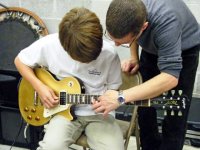Artistic to the Core: Music and Common Core
I'm not a gambling person, but if I had to place a bet on one sure-fire method for engaging students, increasing test scores, reaching students who fall below standards, challenging students who exceed grade-level standards, accessing students' creativity and originality, maximizing brain connections formed, applying concepts to new situations, and making the learning process more fun for the students and teacher, I would place that bet on . . . teaching the core curriculum through the arts.
Our Common Core Standards exist to support students' future success -- namely, college and career readiness. As a former K-12 music teacher now in charge of a music career preparation program for college students, I feel confident asserting that creativity and problem-solving skills acquired through arts training have prepared my students uniquely for their future success. I am truly honored to share with you my thoughts regarding integrating arts into your curriculum.
Why is There Resistance to Integrating the Arts?
If such seemingly guaranteed improvements exist with arts integration, why aren't all teachers using arts while teaching other standards? These are the two biggest mental blocks I see:
- I am not a musician/singer/artist myself, so I do not feel comfortable with the art forms.
- There is no instructional time available to do anything "extra."
Overcoming These Mental Blocks
You certainly do not have to be an "accomplished" artist to integrate the arts into your lessons. You, as a teacher, are creative and original! Teachers must think on their feet, modify plans on the spot, approach content from different angles, support uniqueness, and inspire and foster growth.
Arts integration does not take time away from required Common Core and state standards. Think of teaching standards through the arts, not independently of the arts.
Holding onto misconceptions might prevent you from unlocking your students' creativity, originality and spark for learning. You already have the skills it takes to be a great arts integrator. It's time to dive in and have fun with your lessons.
How to Plan Arts Integration Lessons for Any Teacher
When incorporating arts into lessons, where to begin is often a daunting first step. This activity guides you through that first step -- brainstorming creative, artistic lesson plans connected to your existing standards. Start with a standard or concept you need to address. Ask yourself the following questions, and jot down all ideas you can. Your creative brainstorming will take your students beyond worksheets and unlock your creativity as a teacher and your students' enjoyment of the learning process.
Brainstorming Questions for All Grade Levels
- What is the related historical background? What was the prominent art, music, food, dance, literature and dress?
- Can the topic be written and acted out as a skit by the students?
- Can we visually draw or sculpt the topic or its history?
- How can we move to recreate or interpret the topic?
- Can we show cause and effect through creative movement?
- Are there any related musical pieces to hear and discuss?
- Are there songs we can learn about the topic?
- Can students write their own lyrics about the topic and put it to music?
- Can you write your own song to help students remember important facts? They can help choreograph creative movements to "show" the lyrics (and thus, the facts) through their bodies.
Example Lesson Ideas for an Elementary Classroom
- Animal Identification and Characteristics: Play Saint-Saëns' Carnival of the Animals, and for each part, have students move with the music and guess what animal the composer portrayed. Then draw their favorite animal from that piece, write a poem about that animal (using characteristics, classifications, food source, habitat, etc.) under the drawing, and set the poem to music by using sounds on classroom instruments that represent how the animal might sound/move. Perform the final pieces as your own "carnival of animals."
- Number Awareness: Because math can be a fairly abstract concept, why not put sound and movement to number awareness and equations? Connect math to how sound changes between a musical solo, duet, quintet, 100-piece orchestra, etc. Then, have students create music (using classroom instruments, voices or body percussion) and compare how their sound and overall movement change based on number of players (volume, different instruments heard, different parts being played at the same time, motion needed to create sound, etc.). Students visually, kinesthetically and aurally become math.
- Geometric Shape Awareness and Comparing Shape Attributes: Have students "conduct" music using shapes. Listen to music and ask them to draw shapes in the air that match the music's pattern (number of sides in the shape = groupings of the musical beat). For example:
- A slow waltz (try "Sleeping Beauty Waltz" or "Take Me Out to the Ball Game") has groupings of three beats which could be conducted as a triangle.
- Most pop tunes and marches can be drawn as squares or quadrilaterals because they have strong groupings of four beats (try "Anchors Aweigh" or "Twinkle, Twinkle Little Star").
- Fast waltzes can be drawn as circles because they have a strong one-beat pattern (try "The Beautiful Blue Danube").
- More advanced students could listen to music with groups of five beats and "conduct" pentagons in the air while the music plays (try "Theme from Mission: Impossible").
Through arts-integrated lessons, students are engaged and focused on the content because it takes them beyond the confines of "traditional" learning. They get to hear, see, and become the content through the arts. Good luck and happy planning!
